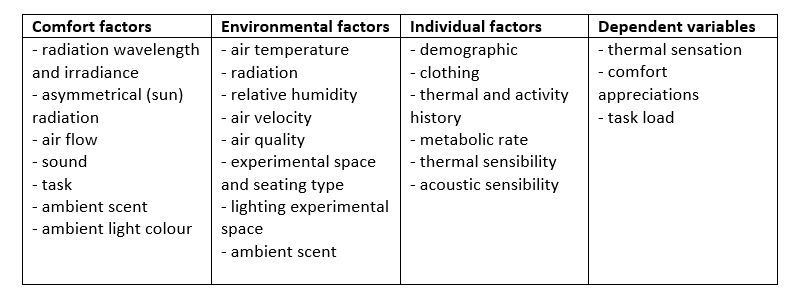Holistic comfort model
Result from partners COV, CRF, IKA, TME and ViF.
Result has been achieved on 31 January, 2020 in month 27 of the project.
Short introduction
The level of comfort in a car does influence purchasing decisions. By developing a new model which allows comfort to be quantified, the DOMUS project is aiming to improve the overall delivery of comfort in a car cabin and the driving range of an electric car. This remarkable attempt to form a holistic comfort model includes factors other than thermal ones, such as individual factors (e.g. gender, thermal & activity history), task, scent, sound, light or radiations (identified in Report 1.1).
The holistic comfort model (HCM) returns a comfort indicator value. It is used by the assessment framework, developed in D1.2., which provides a user-centric assessment of the energy use of a car cabin and climate control system while ensuring it meets expectations for comfort and safety. Details regarding the HCM and its creation process are part of Report 1.3.
Objective
The three main objectives of the task that led to the HCM are:
- Context understanding (further described in previous achieved results):
- develop a contextual understanding of holistic comfort from a psychological perspective.
- Development of methods (further described in previous achieved results)
- overall methods allowing comparability and generalisability and replicability of the data collection over the five study locations
- individual study methods allowing to assess influences on holistic comfort of factors identified
- Analysis and mathematical modelling:
- data-driven approach was taken: we didn’t theorise any particular model and we didn’t insist that any particular aspects were important – we wanted the data to speak for itself
- only include comfort aspects shown to be significant
- predict subjective comfort significantly more accurately compared with the base comfort model
The methods consist of:
- alignment of contextual understanding of holistic comfort
- a defined set of comfort factors that will be manipulated in at least one of the five study
- environmental factors and individual factors that have to be treated as independent variables in the studies (including a description of target levels and measurement set-up when relevant)
- a list of dependent variables to be collected
- general guidelines regarding procedures to follow in the studies, including questionnaire templates allowing to collect data regarding dependent variables and certain individual factors
- analysis of the acquired datasets
Table 1: Factors and dependent variables considered in the overall methods
Results
Key results of this activity include:
- The DOMUS consortium collected and summarised experimental datasets from each of the 5 involved partners, involving a total of 149 participants over an elapsed duration of 242 hours (see details in Table 2).
- We produced comparative results for a series of models and a variety of sub-selections of the experimental datasets. The full aggregated dataset produces a binary comfort classifier with Logistic Regression that 78% of the time is accurate.
- In comparison, the baseline thermal comfort model was only able to correctly predict comfort 58% of the time for the same dataset.
- This deliverable provides the model parameters and associated equations for the best performing model.
Critically, taking into account holistic factors other than just thermal ones is significantly better than just using a thermal model – even when estimating subjective thermal perception. Some of the most important factors identified include: the thermal comfort of the head region, the recent external exposure time, and gender.
Due to the novelty of the approach, there were naturally some methodological issues, and the resulting model should be considered a version 1 rather than a final answer. Clearly more work is needed but a clear starting point has been established.
Table 2: Overview of experimental work in terms of participants and duration
Looking at the DOMUS project, the holistic comfort model meet the requirements set out in the objectives for this part of the project and provided a strong foundation of the DOMUS work to build upon, namely:
- The comfort indicatoroutputs are used in the assessment framework for virtual assessment (Result category 2).
- The model contributed to the definition of sensors sets and additional active comfort components as well as to the definition of user-centred control strategies (Result category 5).




